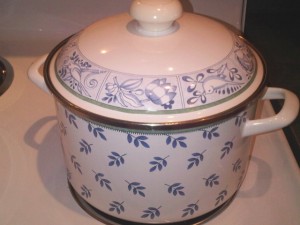
At our house March is soup month. It’s one of the last months where you really feel like making a large pot of soup.
Most of my soups are cooked in a Villeroy Boch enameled soup pot that I purchased many years ago, on sale at Marshall Field’s. It was at their “after Christmas sale” at the Oak Brook store near my house in Chicago. I was with my friend T. She should have been a professional personal shopper. She can find you absolutely anything you want at the price you want to pay. So of course she was at the “90% OFF After Xmas Sale.” I’m sure she also had coupons for an additional percentage off. I remember holding a bag with the Xmas ornaments she already found when I saw them; the last two Villeroy Boch soup pots high up on a shelf in “Market Place” – Marshall Field’s housewares department. Amazingly they were already on sale with an additional amount off. Expensive even on sale – but sooo worth it.
It has been a delight and pleasure to create mouth watering soups in this pot. The enamel interior resists pitting from acids in food and the heavy gauge steel heats evenly. It still looks beautiful and has served me very well over the years.
We try to make a few pots of various soups throughout the month and get single-serving containers of soup into the freezer. Then we can easily enjoy them throughout the summer.
 One of my favorite soups is split pea with ham. Usually this March soup uses the heel of the Easter ham. But Easter is VERY late this year. Using one thick slice of ham or bacon you can make this same soup today. Use green or yellow split peas. Add onions, potatoes, carrots or parsnips as you like following this recipe:
One of my favorite soups is split pea with ham. Usually this March soup uses the heel of the Easter ham. But Easter is VERY late this year. Using one thick slice of ham or bacon you can make this same soup today. Use green or yellow split peas. Add onions, potatoes, carrots or parsnips as you like following this recipe:
In a soup pot, saute coarsely chopped onions in a bit of olive oil. Add six to eight cups of water, 1 package of split peas, diced carrots, two tablespoons of chicken soup bouillon or stock from a jar, one ham slice – cubed. If you prefer vegetarian eliminate the ham. Add freshly grated pepper, 1 tsp garlic powder and oregano (or herbs de Provence). Add one or two bay leaves. Bring to a boil, then simmer on low for two hours, covered. Your house will smell great. When the soup is nice and thick to your liking – serve and top with oyster crackers or a dollop of yogurt.

Today I am making beef barley soup with some leftover potroast. I sauteed chopped onion in olive oil until softened. Then I addd the leftover beef, cubed, along with the leftover gravy, potatoes, carrots and onions. Add 6 cups of water, 1/2 cup of barley, herbs de Provence (or oregano). For an added boost you could add a small can of tomato sauce, or 1 tsp of balsamic vinegar, or 1 good squeeze of lemon juice. Simmer about 2 hours. Serve.

As I am simmering the beef barley soup I decided I may as well make chicken soup with the leftover chicken. Into a pot add the leftover chicken, bones and all. Add any juices or gravy. Fill pot with 6 cups of water. Onion, celery, carrots, garlic, whole peppercorns or chopped cilantro are optional. I am leaving them out today as a plain broth is my goal. But I am adding additional chicken soup base. Simmer all afternoon. Remove bones. Cut up chicken and return to broth. If you like you could add matzo balls to simmer and cook for 1/2 additional hour at this point.
Or try Mark Bittman’s soup matrix to make creamy, brothy, earthy or hearty soups without a recipe.
As the day ends, cozy up to a glass of good wine, a piece of crusty artisan bread, a candle, a friend and enjoy.
Put the remaining soup in canning jars. Take a jar to a neighbor, a friend or anyone who would appreciate a special delivery of homemade soup. Keep chilled until heated for eating. Will keep 2-3 days in the refrigerator.
Ahhh . . . the soups of March . . .
You may also like Winter Comfort Food, Spend Less On Groceries – Eat Better and What Do You Do With Your Leftovers?


